At a time when climate disruptions, global supply chain shocks, and rising food prices are reshaping how the world thinks about agriculture, the question of food security has taken on new urgency even in resource-rich regions like Sarawak.
Enter agroparks – zones aimed at transforming agriculture into a modern, high-value industry. Backed by government policy and public-private partnerships, these parks promise to centralise production, optimise logistics, and encourage the use of new technologies in farming. But beyond the infrastructure, are these parks truly delivering on their promise?
This article explores the role of agro parks in safeguarding Sarawak’s food future – and asks whether digital tools and innovations are being fully leveraged to make these spaces more than just farms, but engines of agricultural transformation.
Background: What Are Agro Parks?
To understand the role agroparks play in Sarawak’s pursuit of food security, it’s important to first unpack what they are (and what they are not). In essence, agroparks are integrated agricultural zones designed to cluster the entire food production chain within a single, purpose-built area.
These zones bring together farming, processing, packaging, storage, logistics, and even marketing all within a shared ecosystem. The idea is simple but powerful: by centralising these activities and supporting them with modern infrastructure and technology, agroparks can create economies of scale, drive efficiency, and encourage innovation.
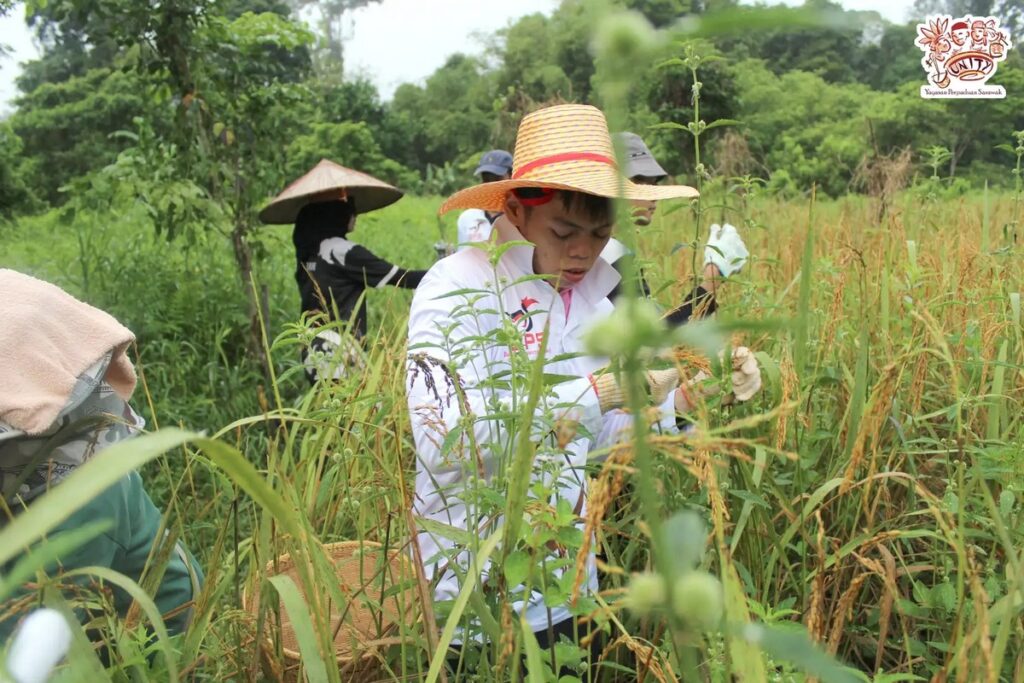
It’s a model that has gained traction globally, with examples in countries ranging from Vietnam to Jamaica, often with the same goal – modernising agriculture while boosting national food self-sufficiency.
In Sarawak, agroparks are evolving from policy experiments to physical realities in various stages of development, each tailored to the state’s diverse geography and economic goals.
Famous Examples of Agroparks in Sarawak
- Bebuling Agropark (Betong Division) spans 300 hectares and stands out for its integrated air transport logistics via the nearby STOLport. The park focuses on vegetables, fruits, poultry, and crayfish – and aims to uplift smallholder incomes through contract farming and technology transfer. Although still under construction, its scale and connectivity suggest high potential.
- Sungai Baji Agro Park (Sarikei), covering 127 hectares, began operations in early 2024. It combines food production with agro-tourism, focusing on commercially viable crops like durians and pineapples. With greenhouses, training facilities, and smart farming systems such as fertigation, it also targets young agropreneurs – positioning the park as both a food hub and a talent incubator.
- SCORE Integrated Agropark (Mukah Division) forms part of the Sarawak Corridor of Renewable Energy and reflects an ambitious blend of agriculture, renewable energy, and eco-tourism. Although in early development stages, the park signals a shift toward tech-driven and sustainability-focused farming in rural Sarawak.
Policy Backing and Strategic Investment
Sarawak’s agroparks are backed by a web of federal and state policies focused on transforming agriculture through technology, infrastructure, and financial support. Under the 12th Malaysia Plan, federal funding supports infrastructure for the Igan Agropark. At the state level, RM376.72 million was allocated in Sarawak’s 2025 budget to modernise agriculture – including agroparks, smart farming, and logistics upgrades.
The state’s prioritisation is clear: Bebuling Agropark’s launch involves collaboration with six agricultural firms, while agro-infrastructure like roads and cold chain systems is being upgraded across divisions. Events like Sarawak Agrofest 2025 showcase the state’s commitment to embedding smart technologies – IoT, data analytics, automation – within its agricultural future.
These efforts are not isolated. They align with broader frameworks like SCORE, which envisions agroparks as part of a sustainable rural transformation strategy – combining food production with clean energy, innovation, and eco-tourism.
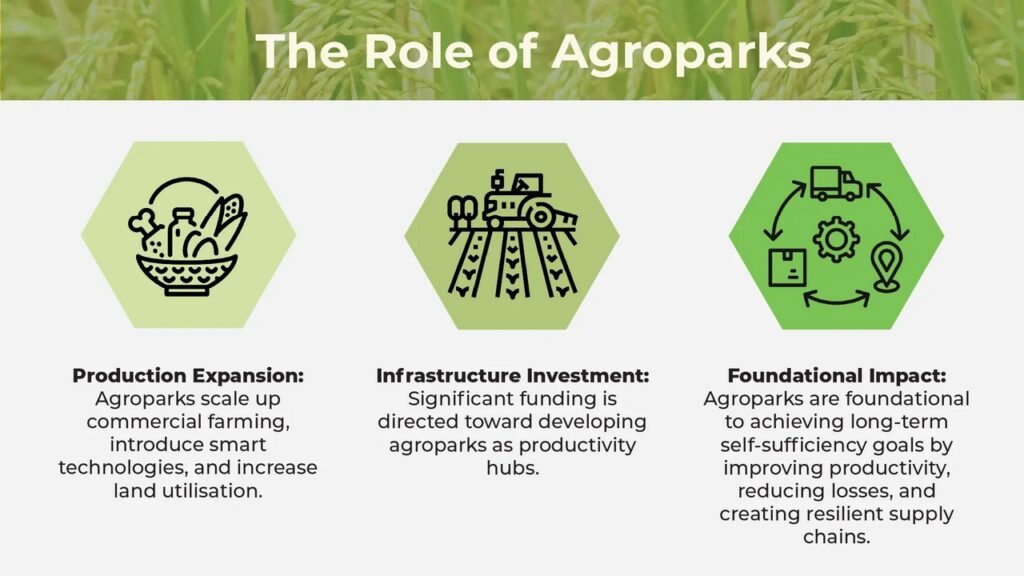
Agroparks: The Food Security Connection
Sarawak’s agroparks are strategically developed to strengthen local food production and reduce dependency on imports through a multi-pronged approach involving agricultural diversification, technology adoption, integrated infrastructure, and policy support.
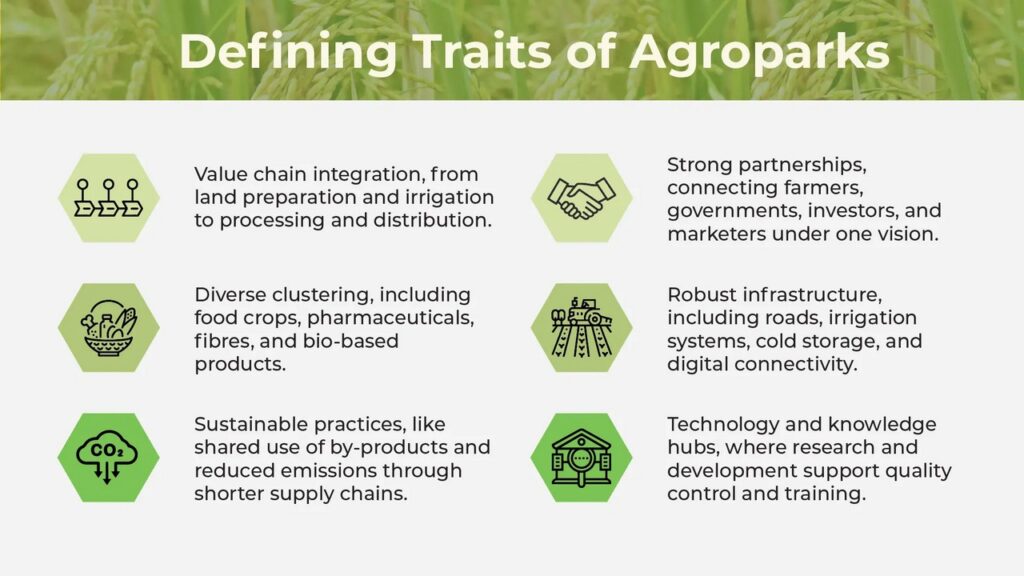
1. Boosting Local Production through Diversification
Agroparks utilise intensive and diversified farming, such as the Four Square Farming (FSF) approach, integrating crops, livestock, aquaculture, and agroforestry to enable year-round, multi-source food production. This reduces exposure to climate volatility and market disruptions while decreasing reliance on imported staples and high-demand foods.
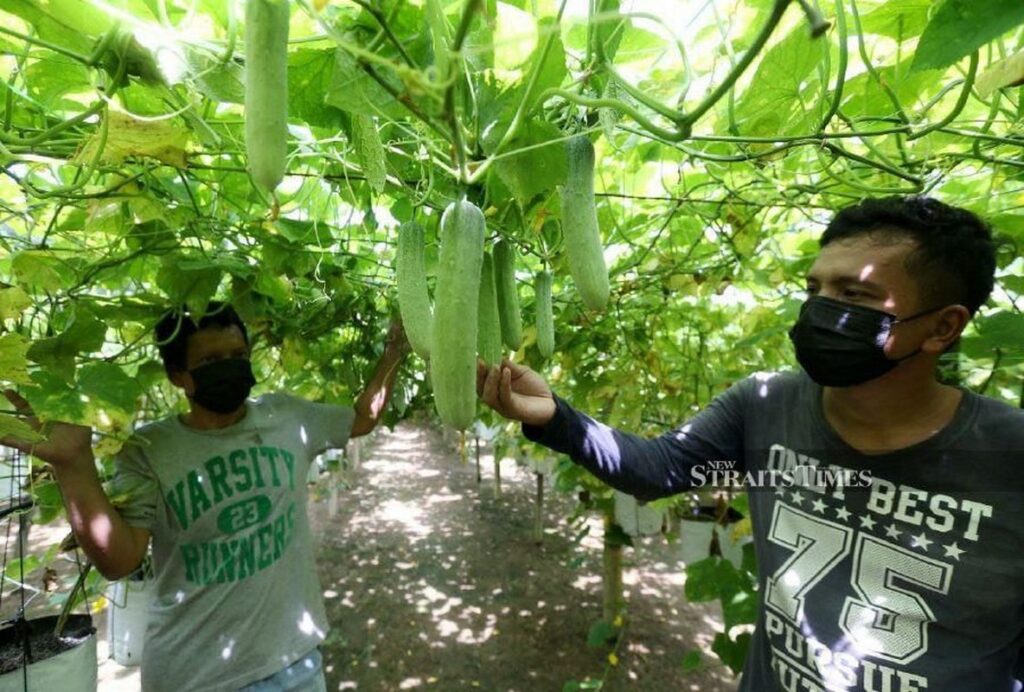
2. Modernisation through Technology Adoption
Agroparks embrace innovations such as precision agriculture, smart farming, AI-powered systems, hydroponics, and fertigation. These technologies significantly enhance yield, efficiency, and competitiveness of local produce, reducing the incentive to import.
3. Integrated Supply Chain Infrastructure
By clustering farming, processing, packaging, storage, and distribution within a single hub, agroparks minimise post-harvest losses, shorten time to market, and maintain freshness. This setup strengthens the domestic supply chain and reduces the need for imported substitutes.
4. Policy Backing and Strategic Funding
The Sarawak government provides substantial investment and policy support to agroparks, aiming for food sufficiency and become a net food exporter by 2030. Key measures include infrastructure upgrades, contract farming incentives, and public-private partnerships focused on staple foods like rice and vegetables.
5. Market Linkages and Cooperative Models
Agroparks promote farmer cooperatives and facilitate access to urban supermarkets, institutional buyers, and digital platforms, ensuring steady demand for local produce and reducing reliance on imports.
6. Sustainability and Climate Resilience
Sustainable practices such as crop rotation, agroforestry, and organic fertilisation enhance soil health and climate resilience. This strengthens local production capacity during adverse conditions that might otherwise trigger higher import levels.
What Is the Agropark’s Role in Improving Local Food Production?
Agroparks serve as catalysts for agricultural transformation by creating high-capacity farming hubs that combine advanced technologies, support infrastructure, and commercialisation frameworks to strengthen local food output.
1. Higher Output and Crop Diversification
Agroparks enable large-scale, intensive farming of high-value crops (e.g., fruits, vegetables, aquaculture) within mixed farming systems. This diversification buffers against supply shocks and ensures steady availability of local produce.
2. Technology-Driven Productivity
Access to greenhouses, hydroponics, IoT devices, and AI-supported tools allows agropreneurs to improve crop yields, efficiency, and product quality. This shifts agriculture from traditional practices to data-driven precision systems.
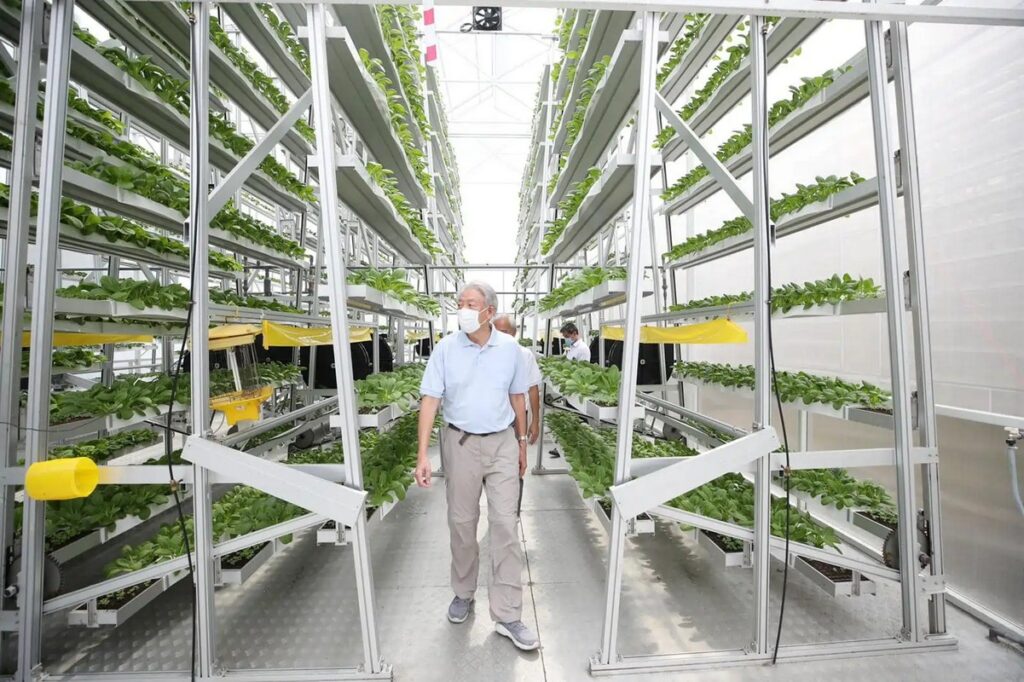
3. Infrastructure and Services
Equipped with farm access roads, irrigation, electricity, internet, collection centres, and packaging facilities, agroparks reduce post-harvest losses and ensure quality control—vital for consistent market access and farmer profitability.
4. Private Sector and Commercial Farming
Agroparks attract private investment and agropreneurs through land leases and anchor company models. This promotes commercialisation and creates economies of scale in agriculture.
5. Youth Empowerment and Capacity Building
Training centres and agro-incubators within agroparks engage young people, bridging labour gaps and encouraging future-ready agricultural careers.
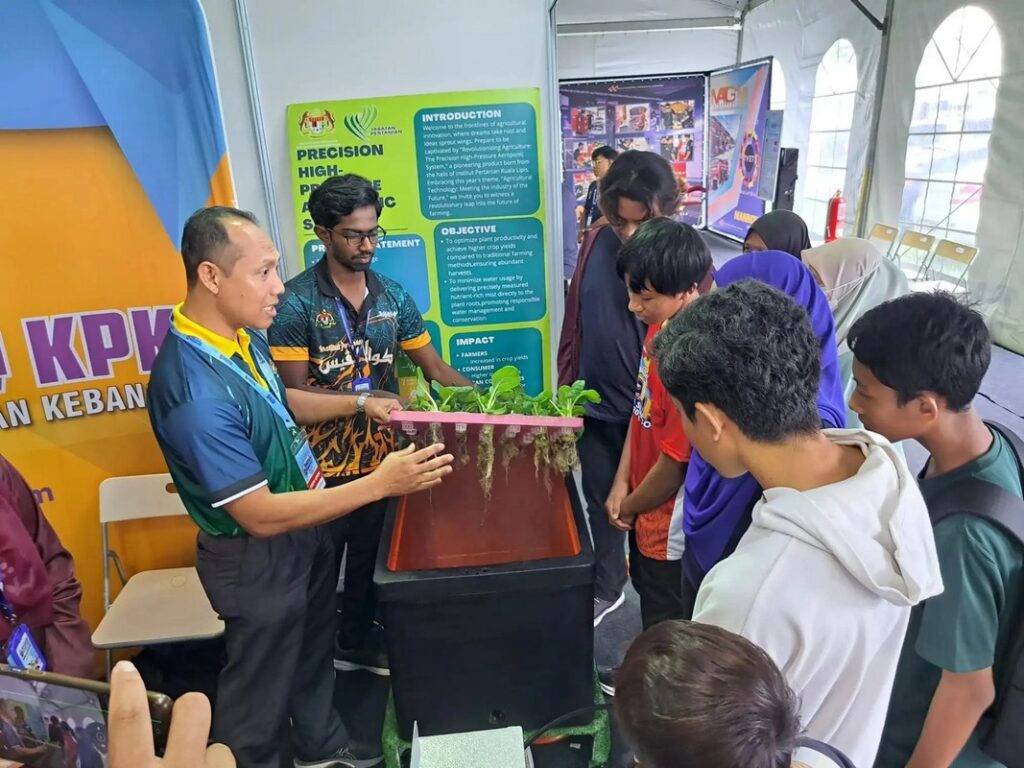
6. Food Security and Export Potential
The agropark model is core to Sarawak’s ambition to become a net food exporter. It boosts domestic supply while creating export-ready systems to access global markets.
How Are Products from Agroparks Distributed?
Sarawak’s agroparks are supported by an evolving logistics ecosystem that includes regional terminals, air cargo links, and smart supply chains to distribute fresh produce efficiently and economically.
1. Regional Food Terminals
Facilities like the one at Sungai Baji Agropark act as centralised distribution hubs, featuring loading bays, packaging areas, storage units, and buyer corridors. These streamline logistics and minimise handling losses.
2. Air Cargo Integration
Bebuling Agropark benefits from direct proximity to the Bebuling STOLport, a short take-off and landing airport. This unique air cargo solution reduces delivery times and spoilage, especially for perishable products.
3. Digital and Smart Supply Chains
Smart logistics systems—powered by IoT and AI—are being implemented to track produce, optimise delivery routes, and reduce waste. Though still emerging, these systems enhance transparency and responsiveness in distribution.
4. Private Sector and Contract Farming Models
Agroparks foster public-private partnerships and involve contract farmers who feed produce directly into the park’s distribution system. This secures a consistent supply for market demand.
5. Direct-to-Consumer Channels and Agro-Tourism
Some agroparks, such as those under SCORE, incorporate farmers’ markets and agro-tourism, opening new avenues for local product marketing and consumer engagement.
Agroparks of Sarawak: Challenges and Blind Spots
While agroparks are central to Sarawak’s strategy for agricultural modernisation and rural transformation, their success depends on overcoming a set of persistent challenges and addressing emerging blind spots. These issues, if left unaddressed, could undermine the inclusivity, sustainability, and long-term impact of the agropark initiative.
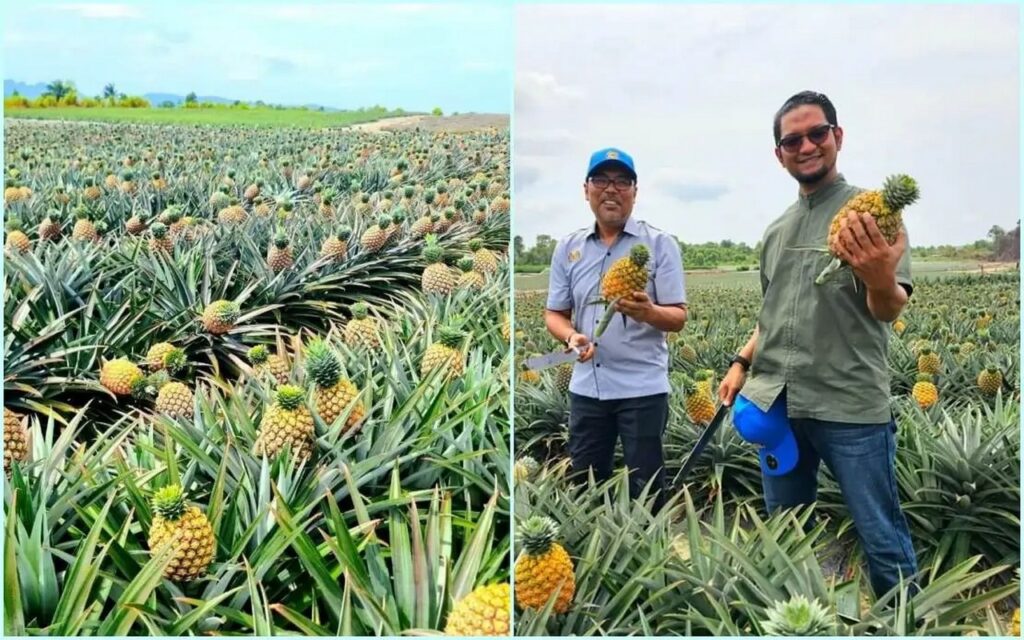
Key Challenges
1. Limited Awareness and Training Among Farmers
A significant number of smallholder farmers remain unfamiliar with the integrated farming systems and advanced practices promoted within agroparks. The transition from traditional monoculture to more diversified and sustainable approaches often requires new skills, which many farmers lack.
Inadequate training and extension services exacerbate this knowledge gap, limiting effective participation and slowing adoption rates.
2. High Upfront Investment Costs
Modern agropark operations—especially those involving livestock integration, agroforestry, and high-tech infrastructure—demand substantial capital. For smallholders, these costs can be prohibitive, particularly in the absence of accessible financing.
While financial support mechanisms such as subsidies, micro-grants, or low-interest loans exist, they may be limited in reach or too bureaucratic to benefit those who need them most.
3. Market Access and Supply Chain Constraints
Agroparks aim to integrate both production and marketing, yet many farmers still face difficulties in securing stable market access. Without strong buyer linkages, cooperatives, or digital platforms to connect producers to urban and export markets, income stability remains uncertain.
These gaps also discourage diversification, as farmers are reluctant to grow crops or rear livestock without assured demand.
4. Infrastructure and Connectivity Gaps
In many rural areas, poor infrastructure—such as inadequate roads, cold storage facilities, and weak digital connectivity—continues to hinder the efficient operation of agroparks.
These deficiencies contribute to high post-harvest losses and logistical challenges. Fragmented development planning and overlapping roles between agencies often delay the necessary infrastructure improvements.
Despite policy support for digital farming, many farmers have yet to embrace smart agriculture. Limited digital literacy, lack of access to appropriate tools, and insufficient on-the-ground technical support are among the factors holding back widespread adoption. As a result, the productivity and sustainability gains envisioned by agropark development remain unevenly realised.
6. Climate Change and Environmental Risks
Sarawak’s agricultural sector is increasingly exposed to climate-related hazards such as floods and unpredictable weather. Although agroparks promote resilience through diversification and controlled-environment agriculture, extreme events continue to pose significant threats. Ongoing investment in climate-smart agriculture and risk management systems is essential to buffer against these disruptions.
7. Youth Migration and Agricultural Labor Shortages
Rural youth often migrate to urban centres in search of better economic opportunities, contributing to labor shortages in agriculture. While agroparks aim to reverse this trend by promoting mechanisation and creating entrepreneurial pathways for young people, the challenge of making agriculture attractive and rewarding enough for youth remains significant.
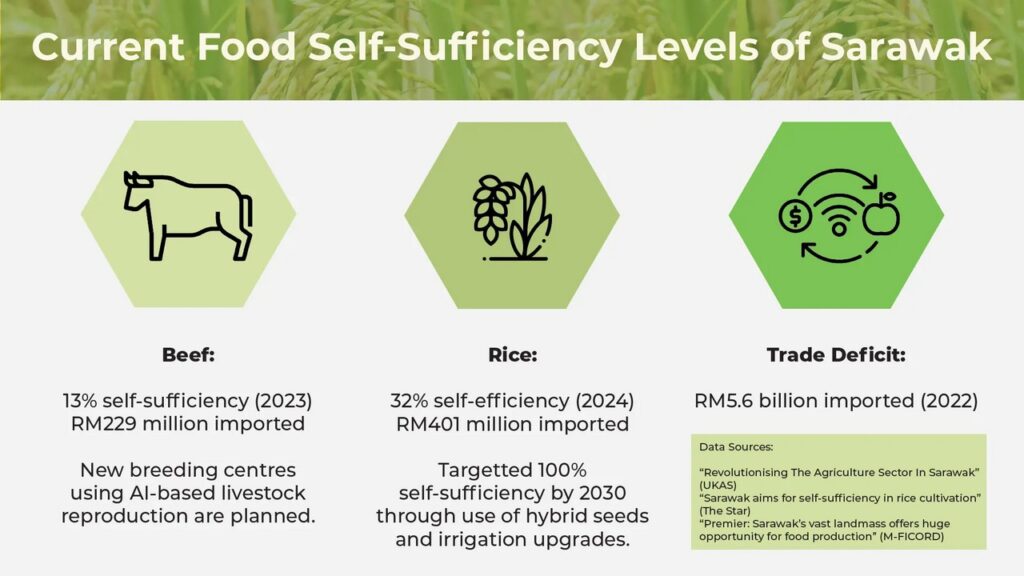
Potential Blind Spots
1. Smallholder Inclusion
Some agropark models may inadvertently favour larger commercial players due to their ability to meet investment requirements and scale. Without deliberate safeguards, smallholders—especially those without secure land tenure risk being marginalised in the transformation process. Ensuring equitable access to agropark benefits is crucial for inclusive development.
2. Coordination Between Federal and State Agencies
Overlapping mandates and fragmented governance between federal and state bodies can hinder efficient agropark development. Delays in implementation, inconsistent policy application, and duplication of efforts often stem from unclear coordination frameworks, limiting the effectiveness of otherwise well-intentioned initiatives.
3. Sustainability Beyond Production
Agroparks are frequently focused on boosting output and technology adoption. However, broader issues such as long-term environmental sustainability, biodiversity conservation, and social cohesion are sometimes underemphasised. Integrating these concerns into agropark planning is essential to ensure lasting ecological and community benefits.
4. Monitoring and Impact Assessment
There is a lack of comprehensive, publicly available data on the tangible outcomes of agroparks—such as their contributions to food security, income growth, or environmental performance. Without rigorous monitoring and transparent reporting, it is difficult to evaluate success, learn from shortcomings, or make evidence-based improvements.
Farming for the Future: Expert Directions and
Recommendations
As Sarawak advances its agropark strategy, aligning with proven frameworks and regional best practices will be critical to ensuring long-term success. Lessons from ASEAN’s Climate-Smart Agriculture (CSA) initiatives and regional smart farming projects offer valuable guidance.
Experts recommend a comprehensive approach that blends innovation, sustainability, inclusivity, and strategic collaboration:
1. Embrace Climate-Smart Agriculture (CSA) Principles
Sarawak’s agroparks can play a pivotal role in advancing climate resilience and sustainable agriculture by adopting ASEAN’s CSA framework. Recommended strategies include:
- Diversified Cropping and Agroforestry: Integrating multiple crop species and agroforestry systems enhances soil health, boosts biodiversity, and improves resilience to climate shocks.
- Water-Saving Irrigation and Resource Efficiency: Techniques such as drip irrigation and fertigation reduce water use and input waste.
- Policy Alignment with ASEAN CSA Guidelines: Coordinating agropark development with regional CSA frameworks ensures strategic coherence and fosters sustainability at scale.
2. Leverage Advanced Digital Technologies
Digitalisation is transforming agriculture across ASEAN. Sarawak can accelerate smart farming by expanding its use of frontier technologies:
- IoT, AI, and Data Analytics: Smart sensors and AI-powered systems improve real-time monitoring, predictive analytics, and precision resource application, thereby enhancing productivity.
- Digital Platforms for Farm Management and Market Access: Mobile apps and e-commerce platforms can connect farmers to markets, inputs, and advisory services, especially in remote areas.
- Smart Farm Pilots and Demonstration Sites: Establishing flagship smart farms across strategic locations will showcase the benefits of digital agriculture and encourage broader adoption.
3. Strengthen Capacity Building and Farmer Empowerment
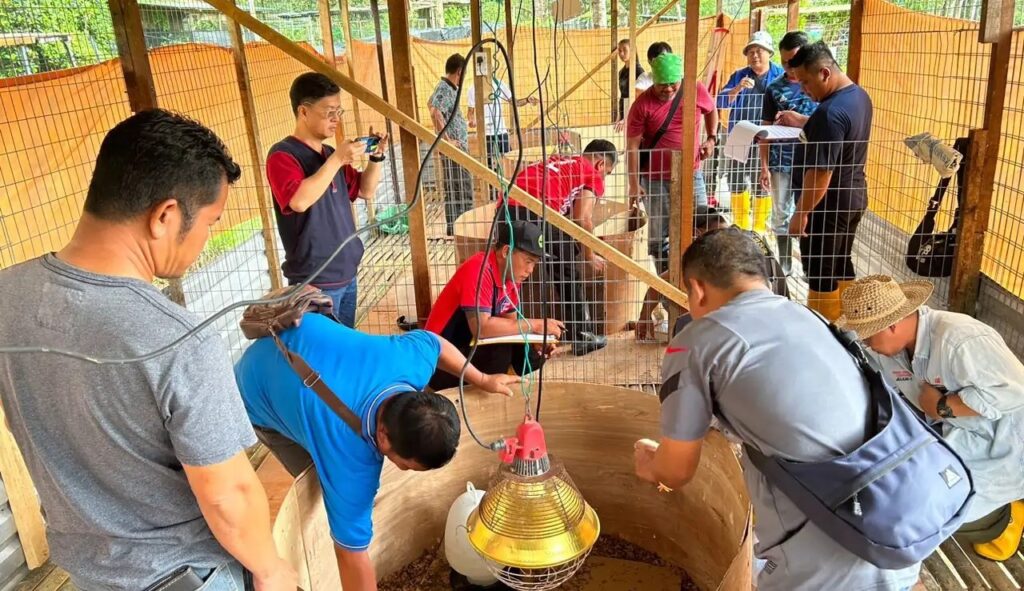
A core lesson from successful ASEAN projects is the need to invest in people. Empowering farmers—particularly smallholders and youth—will ensure that technology and innovation are accessible and inclusive:
- Targeted Training and Advisory Services: Ongoing education on smart farming, climate adaptation, and market practices must be made available, especially to underserved groups.
- Support for Cooperatives: Organised farmer groups can improve economies of scale, reduce input costs, and enhance market leverage.
- Agro-Tourism and Incubation Centres: These initiatives can spark youth interest, provide entrepreneurship opportunities, and revitalise the rural workforce.
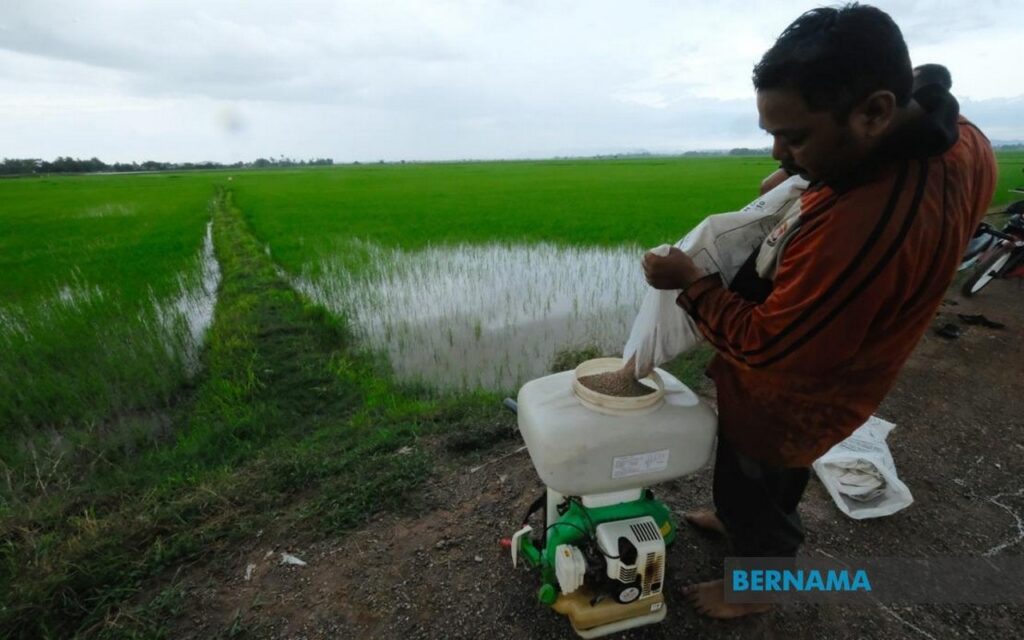
4. Promote Multi-Stakeholder Collaboration and Policy Alignment
Transforming agriculture requires whole-of-system collaboration. Sarawak’s agroparks will benefit from strong institutional linkages:
- Policy Coherence Across Levels: Aligning state agropark policies with federal and ASEAN sustainable agriculture strategies can reduce duplication and improve impact.
- Cross-Sector Partnerships: Collaborations with universities, tech firms, agri-businesses, and civil society organisations can bring in fresh ideas, research, and capital.
- Integrated Value Chains: Agroparks should connect upstream production to midstream processing and downstream marketing, creating more stable and resilient agribusiness ecosystems.
5. Develop Sustainable Value Chains and Green Supply Networks
Modern agroparks must contribute not only to productivity but also to environmental stewardship and food system health:
- Eco-Friendly Infrastructure: Cold chains, logistics, and storage must be designed to reduce emissions and minimise losses.
- Food Safety and Nutrition: Agroparks should prioritise safe, diverse, and locally nutritious food, in line with public health goals.
- Support for Regenerative Agriculture: Practices that restore soil fertility and conserve biodiversity must be embedded into agropark operations to ensure long-term sustainability.
6. Address Financial and Technological Barriers
Wider participation in agroparks hinges on reducing access barriers, especially for smallholders and remote communities:
- Affordable Financing Tools: Credit schemes, subsidies, and incentives must be expanded and tailored to support agropreneurs across income levels.
- Investment in Digital Infrastructure: Rural connectivity and affordable technology solutions are prerequisites for successful smart farming.
- Impact Monitoring and Evaluation: Data-driven assessments can guide policy refinement, track outcomes, and build investor confidence in agropark projects.
Conclusion: Reframing the Big Question
Sarawak’s agropark initiative represents a bold and forward-looking strategy to revitalise the state’s agricultural sector through integration, innovation, and inclusivity. By combining traditional strengths with modern practices like climate-smart agriculture, digital technologies and green value chains, agroparks are poised to become engines of rural transformation and food security.
However, unlocking their full potential will require addressing persistent challenges such as limited farmer awareness, access to financing, infrastructure deficits, and inter-agency coordination. Equally important is ensuring that no group is left behind, especially smallholders and rural youth, in the transition to modern farming.
With sustained policy support, collaborative partnerships, and community engagement, Sarawak can build a resilient agricultural future that meets local food needs and strengthens its position within regional value chains. As agroparks continue to evolve, they will play a crucial role in achieving a more sustainable, equitable, and prosperous future for Sarawak’s farming communities.
References:
- Agroparks – an innovative design approach for metropolitan areas
- Establishing agroparks in Azerbaijan emerges as promising strategy
- Agro-Parks and Economic Resilience
- Sarawak’s Bebuling Agropark draws six major firms
- Devt of farming facilities at Sg Baji Agropark in Sarikei completed, says Dr Rundi
- Transforming Rural Sarawak with SCORE’s Integrated Agropark
- Agro Parks to Bolster Modern Agriculture in Sarawak
- Integrated agropark in Igan to showcase sustainable farming techniques, smart agriculture
- Revolutionising The Agriculture Sector In Sarawak
- Proposed Tanah Putih–Parit Bugis bridge, road upgrades to enhance Sarikei’s agropark plans, says Premier
- Bintulu to host 10-day Sarawak Agrofest 2025, targeting RM6 mln in sales and 600,000 visitors
- Four Square Farming: A possible game-changer for Sarawak’s agriculture
- Exploring Green Farming in Sarawak: Transforming Agriculture for a Sustainable Future
- Sarawak Records RM6.44 Billion Food Trade Deficit In 2024, Calls For Agricultural Transformation
- Sarawak pushes for agricultural modernisation to become net food exporter by 2030
- Achievements of the Agricultural Sector in Sarawak
- Go modern, agriculture sector told
- Work visit to Sungai Baji Agro Park, Sarikei to inspect food terminal project
- Devt of farming facilities at Sg Baji Agropark in Sarikei completed, says Dr Rundi
- Sarawak aims for self-sufficiency in rice cultivation
- Premier: Sarawak’s vast landmass offers huge opportunity for food production
- Enhancing domestic agriculture through agroparks and modern farming technology
- Sarawak govt approves setting up of Agropark in Saribas, says deputy CM
- Bebuling Agropark to kick off development this year
- Making Sarawak Food Secure: Empowering Agriculture with Artificial Intelligence
- Deputy minister: S’wak govt approves RM90 mln to set up three Precision Farming Parks
- Sarawakian farmers slow to adopt modern agricultural technologies due to high costs, lack of skills and knowledge
- Progressing towards Regional Balance
- Factors Influencing the Behavioural Intention for Smart Farming in Sarawak, Malaysia
- Climate-Smart Agriculture: Strengthening Resilience in ASEAN and Beyond
- ASEAN Regional Guidelines for Sustainable Agriculture in ASEAN
- ASEAN Vows Coordinated Action in Shift to Sustainable Agriculture
- ASEAN-CHINA JOINT STATEMENT ON PROMOTING THE DEVELOPMENT OF SMART AGRICULTURE
